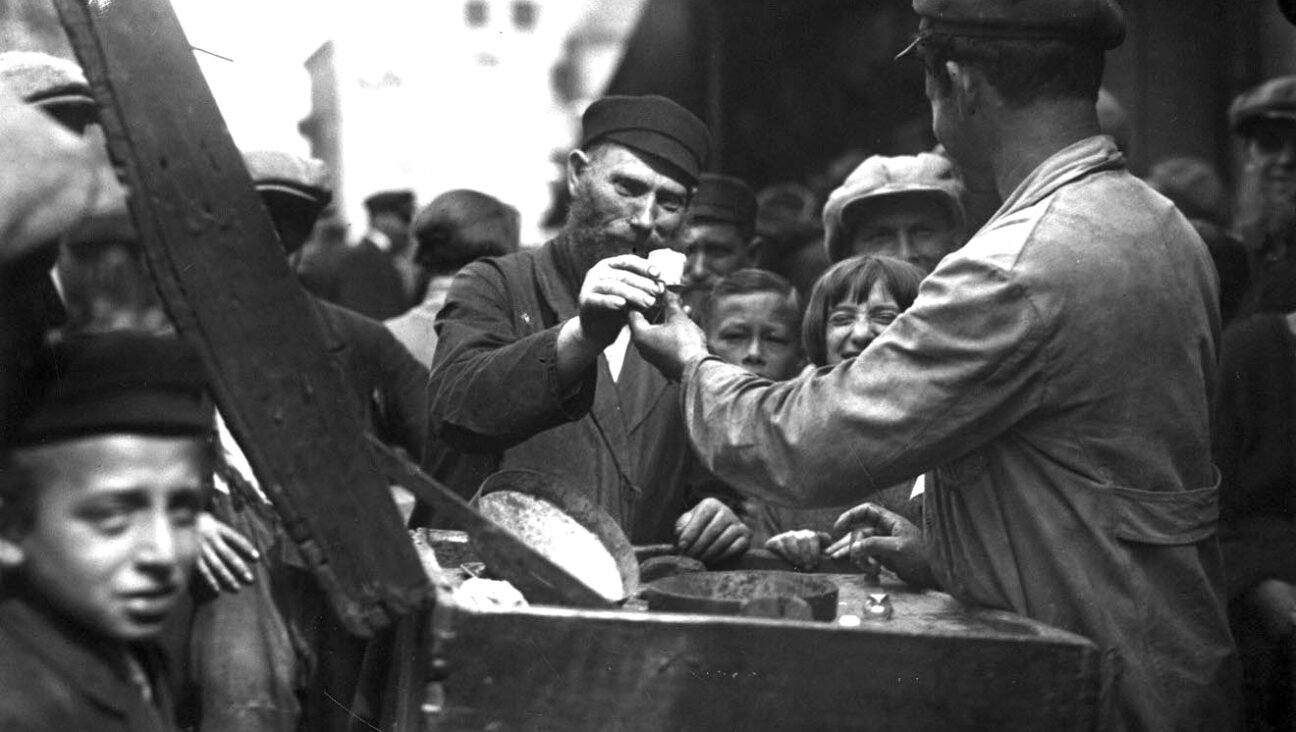The Jewish Relationship with Food — Part 1

Graphic by Angelie Zaslavsky

Image by Thinkstock
Moment Magazine asked 18 experts “Is There a Secret Ingredient in the Jewish Relationship with Food?” in their latest issue — and got some fascinating answers. Below are three of them and we’ll post three more in the coming days with permission from the magazine. We want to hear what you think. Share your thoughts in the comments.
Gil Marks
There is no way you can practice Judaism religiously or culturally without food. Food has been intrinsic to Jewish ritual, life and culture from the outset. What is the very first act that the Israelites in Egypt are commanded to do? It’s to have a communal meal—roast lamb and herbs, some nice shwarma. And with that, the beginning of the Jewish people is through a meal. The famous joke—“They tried to kill us, we won, now let’s eat”—is not really that far from the truth. Within the Jewish legal framework is an understanding that various rituals are accompanied by a seudat mitzvah, or celebratory meal, whether a bris or a baby naming or a bar mitzvah or a wedding. Any sort of life cycle event is accompanied by a seudat mitzvah. Some foods are almost sanctified by their use in these meals or holidays and rituals. So food that may have not been Jewish at one point can become Jewish. Chicken soup, for example, became very popular after a meat shortage after the Black Death, leading Europe to become a chicken-raising culture. Simultaneously, Italian Jews introduced noodles to the Franco-German Jews, and chicken soup with frimzel, or egg noodles, became standard. But then what do you do on Pesach when you can’t have egg noodles—the matzoh ball or knaidel emerges. You can see the continuing adaptation that created the cultural Jewish gastronomy.
Gil Marks is a rabbi, author of Encyclopedia of Jewish Food and founding editor of Kosher Gourmet magazine.
Claudia Roden
All Jews in Europe kept kosher until the 19th century, when they were emancipated and moved to the big cities—and many stopped keeping kosher. But most Jews in communities in the Muslim world went on abiding by kosher rules until the 1950s, when they started to leave their Muslim homelands. For the Jews of the diaspora, food has always been important, because observance of the dietary laws created a spiritual atmosphere around it. And when they stopped keeping kosher, the “Jewish foods” from their old homelands became even more important, because they were part of their identity. For Jews who weren’t very religious, who had lost their old languages—like Yiddish, Ladino or Judeo-Arabic—food became one of the things that they held onto to remind themselves of who they were, of their past and their ancestry. Sometimes they have been labeled gastronomic Jews. In the last few years I’ve been traveling a lot—to Australia, New Zealand, South Africa, Berlin, Vienna, Amsterdam—and I could see that some of the Jews there who were no longer keeping kosher were very concerned with keeping up their Jewish food traditions on the Sabbath and on festive occasions. Even some people from Russia, for instance, who didn’t eat traditional Jewish food at all through the communist years, are looking for recipes. All Ashkenazi Jews had a similar culture and similar dishes even though they came from many countries in Eastern, Central and Western Europe; theirs was almost a fixed menu, from challah and chicken soup to gefilte fish, chopped herring and chopped liver. Jews who are not Ashkenazi, who are now all referred to as Sephardi, have different dishes. Although the communities differed from one country to another and sometimes from one city to another, some similar dishes could be found all over the Sephardi world. Among these are meat stews with fruit—lamb with apricots, prunes or cherries—which they picked up in Baghdad, and their Passover almond cakes and almond cookies that they adopted in Spain. Jewish dishes are kept because of what they evoke and represent, because they are a part of Jewish cultural identity. I don’t expect they’ll disappear completely.
Claudia Roden writes about the history and culture of food and is the author of The Book of Jewish Food, among other books.
Yotam Ottolenghi
In some ways, what happened in Israel is the exact opposite of what happened in the diaspora. When Jews came to Israel, the food they brought with them became their defining feature, whereas in their countries of origin, food identified them as Jews. That’s the paradox of immigration. When I was growing up in Israel, at school we had events where kids would bring food from their country of origin. A Jew from Poland would bring typical Polish food, such as gefilte fish and all kinds of sweet cakes. Jews from Iraq would bring their soups and all the things that are related to Iraqi cooking. Those events were meant to celebrate the diversity of various communities and to bring everyone together around food. Because of this, and its relatively young age, Israel has only just begun to establish its own cohesive cuisine, and it will probably take a few decades or more for it to become something that has a clear voice. Of course, there are ingredients that Israelis eat a lot of, such as chickpeas, tahini and aubergines. These are indigenous ingredients that are common in the eastern Mediterranean and the Middle East and that came to Israel either through Jews’ countries of origin or because they were cooked here already by Palestinians. But there are some dishes that Israelis would argue they created. The Israeli version of falafel in a pita came about in the 1950s, when Yemenite Jews added schug [a type of hot sauce] to this Arab meal-on-the-go. Israeli culture now claims this as the national dish.
Yotam Ottolenghi is a chef, co-author of Jerusalem: A Cookbook and author of Ottolenghi: The Cookbook, to be released in September.
















